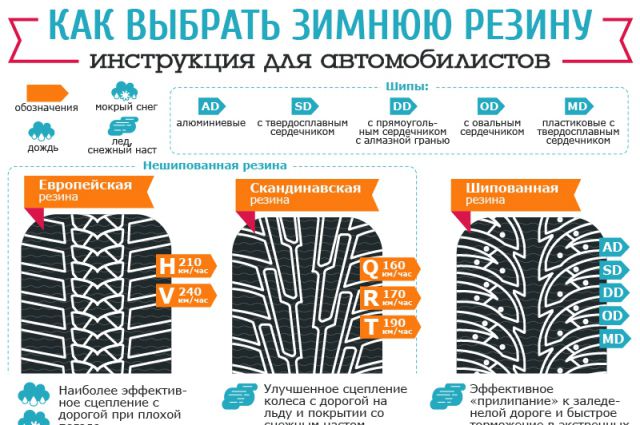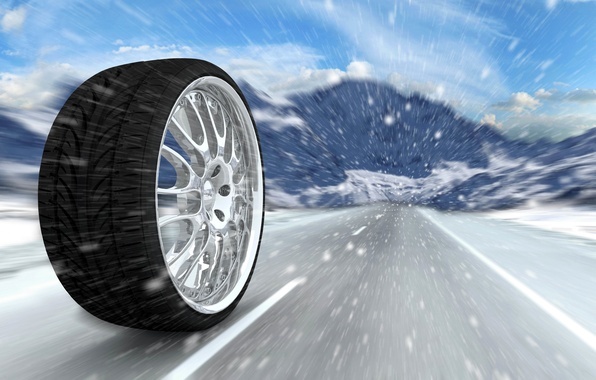
How to choose the right winter tires for your car
Content
Do we need winter tires
Summer tires are designed for high speeds and mostly dry surfaces. Winter tires are designed to ensure safe driving on muddy, snowy and icy roads.
The all-season kit, which is installed on many cars sold in car dealerships, is acceptable for countries and regions with warm climates and mild winters. But such conditions are not typical for most of the territory of our country, not to mention Russia or Belarus. Here, winter car “shoes” are not a luxury, but a necessity.
Rigid all-season tires at temperatures below -10°C become too hard, which increases the braking distance and increases the risk of an accident. Summer tires at this temperature resemble plastic, and at -40 ° C it becomes brittle, like glass.
Today, often the best prices for tires can only be found in the online tire store.
For our climatic zone, all-season is not an option even for all-wheel drive cars. Therefore, each motorist should have two sets of tires - summer and winter.
It is better to buy winter tires in advance, in the summer, when prices are lower and there is time to calmly consider the choice. High-quality, properly selected tires (https://vezemkolesa.ru/tyres) will add peace of mind and confidence while driving.
When preparing for the winter period, it is worth focusing on a temperature of + 7 ° С. If the thermometer has crept up to this mark, then it's time to change your car's shoes into winter tires.

Thorns
Winter tires are studded and friction (non-studded). You can find these tires on this page - https://vezemkolesa.ru/tyres/zima
Studded tires have metal inserts in the tread that improve traction on very slippery surfaces. They have a more aggressive tread pattern, which provides increased flotation in the snow.
They are worth buying if you often have to travel out of town, drive on dense rolled snow or heavily icy roads. In difficult winter conditions, studs will be the best solution for not very experienced drivers.
The number of spikes can be different, but the more there are, the more noticeable they are, annoying drivers. This factor must be taken into account when buying.
The spikes are not suitable for fast driving, at speeds over 120 km / h they just start to fly out.
On wet pavement, the braking distance of studs is longer than that of friction tires.
Studded tires wear out quite quickly when driving on clean asphalt and can damage the road surface. For this reason, in many European countries it can only be used on uncleared tracks and with a limited number of spikes. This is something to keep in mind if you plan to travel to Europe in your car.
Velcro
For local city roads in winter, a mixture of mud and loose melted snow is more characteristic. In conditions of snowy “porridge”, friction tires, which are popularly called “Velcro”, will be the best choice. They do not have spikes and a different tread pattern. There are two types of Velcro - European and Scandinavian (Nordic).
Non-studded European-type tires give good handling in rain or wet snow. The tread has a developed network of drainage channels and a large number of thin slots (lamellae).
The lamellas wrap around the small unevenness of the asphalt, providing a reliable grip on the surface. These tires seem to stick to the road. Obviously, that is why they are called Velcro.
European Velcro performs well on dry and wet surfaces. Lugs on the outer edges of the tread improve flotation in wet ground and clay. They can be used if you live in a southern city and rarely travel outside of it. But it should be remembered that such tires are not very good on an icy track.
For the rest of our country, it is better to choose Scandinavian-type friction tires. Compared to European ones, they have a softer rubber compound. The pattern is dominated by rectangular and diamond-shaped elements, it is more sparse, and its depth is about 10 mm. The number of lamellas is much larger than on European Velcro. The sidewall of Nordic tires has an almost right angle, unlike the more rounded European ones.
Scandinavian tires are indispensable on snow-covered roads, perform well in icy conditions, but on clean asphalt they can be noisy and wear out faster.
While the tread pattern is important, it should not be the deciding factor when choosing a tire. Appearances can be deceiving. It all depends on the accuracy of the calculations and tests carried out by the manufacturer. The differences may be small, but significant. A visual assessment will hardly help here.
When choosing a particular model, it is better to rely on test results, while not forgetting that some tests may be custom-made.
How many winter tires do you need to buy
Some motorists, in order to save money, purchase winter tires only on the drive wheels. This is an erroneous approach, especially if one axle is in spikes and the other is in summer “shoes”. Due to differences in grip, the risk of skidding and accidents increases dramatically.
Therefore, you need to “change shoes” for a car completely. For maximum safety, all tires must be of the same make and age. Under no circumstances should tires with a different type of pattern and carcass structure be used on the same axle.
Don't forget the spare. If a wheel bursts on the road, replacing it with a tire with summer tires will not lead to anything good.
What tires are considered old
Be sure to pay attention to the date of manufacture. Rubber ages even if not used. Cracks may appear, performance properties deteriorate. The degree of aging largely depends on the storage conditions. The shelf life of new tires is 5-6 years. If the age approaches this figure, it is better to refrain from buying them. Some experts do not recommend purchasing winter tires manufactured more than two years ago.
Is it possible to save
The price is not always proportional to the quality. How much a winter set will cost you depends on the brand, country of origin, model. There is room for maneuver here.
The higher the speed index, the higher the cost of tires. Winter is not the best time for racing. Most motorists can do without high-speed winter tires.
A set with a smaller landing size will cost less. True, they will need the appropriate disks.
You don't have to buy the latest model. Last year's may not be much inferior to new ones, but they will turn out to be cheaper.
Sub-brands of well-known tire manufacturers produce copies of models that were on the market under the brand name of the main brand in previous years. They also cost less. Such sub-brands for Continental are Mabor, Barum, General Tire, Viking, Semperit, Gislaved. Nokian has Nordman; Goodyear has Fulda, Debica, Sava.
Should I buy used
A used set is much cheaper than a new one. However, the savings when buying it is rather doubtful. Such wheels are already worn out to some extent, which means that they will function worse and last longer.
downward.
If winter tires were used in the hot season, then it most likely became more rigid and its characteristics generally deteriorated. When buying used tires, you cannot be sure that they were used only in the corresponding season.
Therefore, if you do not want unpleasant surprises, buy a new kit from a reliable manufacturer.
Don't forget to roll
New winter tires must be run in for about 500 km. This applies to spikes and Velcro. This must be done before ice has appeared on the roads and frosts have not yet hit. During the break-in process, sharp accelerations and decelerations should be avoided and the speed should not exceed 70-80 km/h.
During subsequent installations in future seasons, care must be taken to ensure that the tires rotate in the same direction as during the initial break-in.
